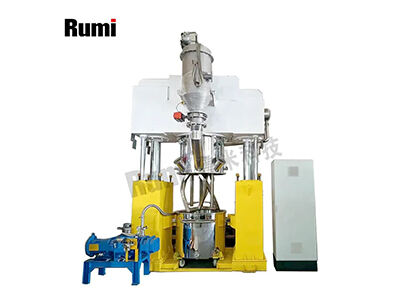Trong thế giới keo, việc lựa chọn công cụ trộn phù hợp giúp tạo ra sản phẩm tốt hơn và đồng đều hơn. Với bản chất phức tạp của keo có độ nhớt cao, cần cân nhắc nhiều yếu tố để xử lý chúng hiệu quả và đạt được kết quả mong muốn. Dưới đây sẽ nêu rõ các quy trình kỹ thuật trong việc lựa chọn máy trộn phù hợp cho keo có độ nhớt cao, tập trung vào các loại máy trộn hành tinh, trộn ribbon và trộn ba trục.
Độ Nhớt, Tốc Độ Cắt Và Khối Lượng Mẻ Trộn: Hướng Dẫn Kỹ Thuật Để Chọn Máy Trộn Hành Tinh, Ribbon Hoặc Ba Trục Trong Sản Xuất Keo
Vì keo có độ nhớt cao do Công Ty TNHH Công Nghệ Điện Cơ Thượng Hải Rumi đóng vai trò quan trọng trong ngành công nghiệp, việc trộn chúng gặp nhiều trở ngại đòi hỏi giải pháp chuyên dụng. Nhiều yếu tố cần được xem xét khi lựa chọn máy trộn, nhưng độ nhớt, tốc độ cắt và khối lượng mẻ trộn là những yếu tố chính.
1. Độ nhớt: Chất kết dính chủ yếu được đánh giá thông qua độ nhớt của chúng khi nói đến đặc tính chảy. Các vật liệu có độ nhớt cao gặp khó khăn trong việc trộn đều do không dễ dàng chảy. Máy trộn hành tinh được trang bị đặc biệt để trộn các loại vật liệu này vì thiết kế lưỡi dao kép và mô-men xoắn mạnh đảm bảo chúng được trộn đều.
2. Tốc độ cắt: Tốc độ mà một vật liệu biến dạng khi áp suất cắt được áp dụng có thể được gọi là tốc độ cắt của nó. Bằng cách áp dụng tốc độ cắt phù hợp, cấu trúc của chất kết dính sẽ không bị ảnh hưởng khi đạt đến cùng mức độ đồng nhất. Việc trộn các chất kết dính có độ nhớt trung bình khá hiệu quả với máy trộn ribbon, tuy nhiên những chất có độ nhớt cực kỳ cao sẽ không trộn đều trừ khi có sự hỗ trợ bổ sung.
3. Khối lượng mẻ trộn: Một yếu tố quan trọng khác cần lưu ý là lượng keo cần trộn tại một thời điểm. Nếu bạn sử dụng mẻ lớn hơn, máy trộn ba trục sẽ rất hữu ích vì nó kết hợp các ưu điểm của máy trộn kiểu hành tinh và máy trộn cắt cao. Nhờ sự phối hợp của nhiều bộ khuấy, những máy trộn này lý tưởng để xử lý lượng lớn nguyên liệu thường yêu cầu trong môi trường công nghiệp.
Từ Nhựa Epoxy đến Keo Cấu Trúc: Lựa Chọn Loại Máy Trộn Phù Hợp với Hồ Sơ Độ Nhớt Trong Công Thức Công Nghiệp
Mỗi loại keo với công thức khác nhau thường đòi hỏi kỹ thuật trộn riêng biệt do đặc tính độ nhớt khác nhau. Việc hiểu rõ các hồ sơ độ nhớt này là cần thiết để lựa chọn đúng công cụ trộn thích hợp.
1. Nhựa Epoxy: Keo epoxy được biết đến rộng rãi nhờ khả năng bám dính mạnh mẽ và chống chịu được nhiều yếu tố môi trường khác nhau, đồng thời thường có độ nhớt ở mức trung bình hoặc cao. Những máy trộn này có khả năng trộn đều tất cả các thành phần, từ đó giúp tăng cường độ bền cấu trúc cho keo.
2. Keo Cấu Trúc: Đối với những vấn đề kỹ thuật phức tạp, keo dán cấu trúc phải trải qua một quy trình sản xuất phức tạp và thường trở nên rất đặc. Với ba trục, máy trộn có thể được điều chỉnh để phù hợp với tính chất của keo dán và đảm bảo rằng các mẻ lớn hơn sẽ được xử lý đúng cách.
3. Các loại keo dán độ nhớt cao khác: Khi các loại keo dán như polyurethane hoặc silicone cần được trộn lẫn, một phương pháp đặc biệt dựa trên độ nhớt đặc trưng của chúng là rất quan trọng. Việc sử dụng máy trộn dạng ribbon có thể hữu ích khi có thể thực hiện những thay đổi nhỏ trong công thức pha chế hoặc điều kiện nhiệt độ nhằm làm cho quá trình trộn dễ dàng hơn.
Cuối cùng, việc lựa chọn máy trộn phù hợp cho keo đặc không chỉ gói gọn trong một tùy chọn duy nhất. Loại keo được sử dụng đòi hỏi phải hiểu rõ về nó, những tính chất mà sản phẩm cuối cùng nên có, và mức độ sản xuất mong muốn là gì. Nếu xem xét kỹ về độ nhớt, tỷ lệ co ngót và tư duy theo từng mẻ sản xuất, thì việc cải thiện hiệu suất và chất lượng sản phẩm sẽ trở nên dễ dàng hơn. Sự tương thích giữa loại máy trộn và độ nhớt của nhựa epoxy và các loại keo cấu trúc giúp bạn đạt được kết quả tốt hơn và tăng lợi nhuận trong quá trình sản xuất. Các ứng dụng có độ nhớt cao thường được hưởng lợi từ việc sử dụng máy trộn hành tinh và máy trộn ba trục, tuy nhiên máy trộn ribbon cũng có thể hữu ích đối với nhà sản xuất khi cần thiết và cung cấp giải pháp toàn diện cho nhiều nhu cầu công nghiệp. Bất cứ khi nào các nhà sản xuất suy nghĩ thấu đáo trong quá trình xây dựng công thức keo, họ có thể đảm bảo rằng sản phẩm của họ luôn đáng tin cậy.
 EN
EN
 AR
AR
 BG
BG
 HR
HR
 CS
CS
 DA
DA
 NL
NL
 FI
FI
 FR
FR
 DE
DE
 EL
EL
 IT
IT
 JA
JA
 KO
KO
 NO
NO
 PL
PL
 PT
PT
 RO
RO
 RU
RU
 ES
ES
 SV
SV
 TL
TL
 ID
ID
 LT
LT
 SR
SR
 SK
SK
 SL
SL
 VI
VI
 HU
HU
 TH
TH
 TR
TR
 FA
FA
 MS
MS
 BE
BE
 IS
IS
 AZ
AZ
 BN
BN
 EO
EO
 LA
LA
 MN
MN



